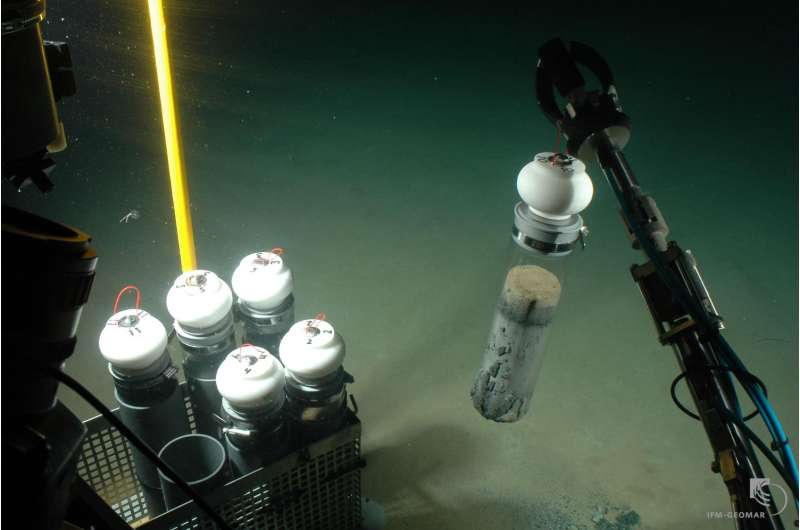February 13, 2017 report
Black Sea study shows short-term oxygen loss at sea bottom can drive out organisms for long periods

(Phys.org)—An international team of researchers has found evidence in the Black Sea that suggests that even short periods of oxygen deprivation on the sea floor can cause animals and microbes that break up plant and animal matter to leave for very long periods of time. In their paper published in the journal Science Advances, the team describes their study of sea floor oxygen levels in the Black Sea and explain why their findings could have an impact on global warming.
When plants and animals that exist in the sea die, they are partially decomposed as their remains fall to the sea floor. Once there, bottom feeders and microorganisms continue the work of recycling such material back into the ecosystem. Sometimes, however, this process is interrupted by a loss of oxygen in a given undersea area, and some material on the bottom of sea the does not decompose—instead, it forms a sort of blanket of muck. There are natural processes that lead to oxygen-deprived zones in oceans and seas, but there are also human-made processes.
Fertilizers farmers use on crops, for example, make their way into rivers and streams and eventually into the sea—the Gulf of Mexico has a very large dead zone for this very reason, because algae that feed on the fertilizer suck up all the oxygen. Very little science has been conducted on accumulations of sea floor sediments due to oxygen deprivation, the researchers note, which is why they chose to set up sea-floor monitoring devices along a 40-kilometer stretch of the Black Sea—the largest oxygen-starved body of water in the world.
In studying data from their monitoring devices, the researchers found that 50 percent more organic matter was preserved in surface sediments exposed to hypoxia compared to oxygen-rich bottom waters. They also found that low oxygen events of just a few days could drive away animals and microorganisms for years or even decades. These findings, they note, have particular relevance as the planet warms—warmer water holds less oxygen and reduces recycling as warmer water tends to stay near the surface.
More information: Gerdhard L. Jessen et al. Hypoxia causes preservation of labile organic matter and changes seafloor microbial community composition (Black Sea), Science Advances (2017). DOI: 10.1126/sciadv.1601897
Abstract
Bottom-water oxygen supply is a key factor governing the biogeochemistry and community composition of marine sediments. Whether it also determines carbon burial rates remains controversial. We investigated the effect of varying oxygen concentrations (170 to 0 μM O2) on microbial remineralization of organic matter in seafloor sediments and on community diversity of the northwestern Crimean shelf break. This study shows that 50% more organic matter is preserved in surface sediments exposed to hypoxia compared to oxic bottom waters. Hypoxic conditions inhibit bioturbation and decreased remineralization rates even within short periods of a few days. These conditions led to the accumulation of threefold more phytodetritus pigments within 40 years compared to the oxic zone. Bacterial community structure also differed between oxic, hypoxic, and anoxic zones. Functional groups relevant in the degradation of particulate organic matter, such as Flavobacteriia, Gammaproteobacteria, and Deltaproteobacteria, changed with decreasing oxygenation, and the microbial community of the hypoxic zone took longer to degrade similar amounts of deposited reactive matter. We conclude that hypoxic bottom-water conditions—even on short time scales—substantially increase the preservation potential of organic matter because of the negative effects on benthic fauna and particle mixing and by favoring anaerobic processes, including sulfurization of matter.
Journal information: Science Advances
© 2017 Phys.org




















